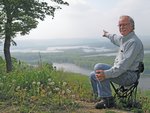




The research for Thomas Becknell’s recent book, “Enchantments of the Mississippi,” began years before he actually wrote the book. “At the outset, I must have read at least a hundred Mississippi River narratives,” said Becknell, who taught literature and writing in St. Paul for 35 years.
“It has been fascinating to read the accounts of so many different ways people have encountered the Mississippi River – paddling, rafting or just being near the river, and writing about their experience. So many different stories,” he said.
These stories of numerous historic figures and their connection to the river, as well as those lesser known individuals he meets on his travels, set Becknell’s book apart. He also takes the reader with him on his exploration of the Mississippi, and provides a sense of place and an understanding of his fascination with the river.
“All the time I spent on the river and along the river – exploring, observing, listening, and paying attention – was as much a part of research as time in the archives,” Becknell continued. “When I actually began the process of writing, turning my notes into narrative was a real pleasure, and time seemed to stop. Writing ‘Enchantments’ was a great joy, and I hope that comes through in the writing.”
Becknell said he did not initially set out to write a book, but once the river fully caught him, he had to write about it. “It’s kind of like falling in love – not so much a decision as an enchantment,” he claimed.
Becknell said he likes to set foot on the spaces he writes about, if it is possible. “The contemporary Kiowa author N. Scott Momaday said that everyone should, at least once in their life, give themselves up to a particular landscape, look at it from as many angles as possible, wonder about it, imagine being there at various times and seasons,” he stated. “I began doing just that with the Mississippi River Gorge, near the Longfellow community, and continued the habit with other parts of the upper Mississippi – its many confluences, its bluffs, bottomlands, and bends in the river. It had the feel of a great pilgrimage.”
According to Becknell, he approached the river with a holy sense of terror. “It’s such an enormous and powerful body of water, representing many different things for different peoples. In this book, I tried to capture – not only through my own experiences, but also through the many stories I encountered – the river’s enormous mystery and multiple associations.”
One story Becknell tells in his book is about his meeting with Jerome. It is in a chapter about unexpected meetings and transformations. Becknell recalled that each of the river’s many confluences changes the river, and that his encounter with Jerome changed him.
“I had been looking for a solitary experience at that particular confluence with the Wisconsin River, and instead, there was Jerome at sundown offering me a beer and conversation. His unique perspective on the river was one of many small transformations I experienced on my journey,” Becknell said.
On his journey, he also connected with Jim Bear Jacobs, a Mohican and Christian pastor who works for cultural healing and reconciliation through Healing Minnesota Stories. “His stories of the Dakota experience are transforming,” Becknell said, “but his encouragement to all his participants is to ‘Tell your own stories. You are stories wrapped in bodies.’”
Becknell also recalled the Nigerian author, Chimamanda Ngozi Adichi, who gave a TED talk some years ago on the danger of a single story. Becknell said Adichi related that stories are who we are, how we know ourselves and each other. “She said there is a grave danger for all people in having only one story, and in refusing to hear the stories of others.”
In his book, Becknell has made sure to include the perspectives of all who are in some way enchanted by the Mississippi. “Long before Europeans arrived on this continent, Indigenous peoples were drawn to the great river, building cities like Cahokia (near present-day St. Louis), constructing effigies and mounds all along its banks and bluff tops, and trading at its many confluences, like Bdote,” he said. “Unfortunately so much of what the river meant to them is lost to time. What the European immigrants called the falls of St. Anthony were known to the Dakota as Owamniyamni, and the Ojibwe as Kababikah, and both nations held them sacred.”
Becknell said he would like his readers to take from the book a sense of enchantment, of being spellbound, of connection with the world one inhabits and with a presence much larger than oneself.
“I like to think I’ve told a story of falling in love with the currents of time, the beauty of life and the consolation of the spirit.”
Comments
No comments on this item Please log in to comment by clicking here